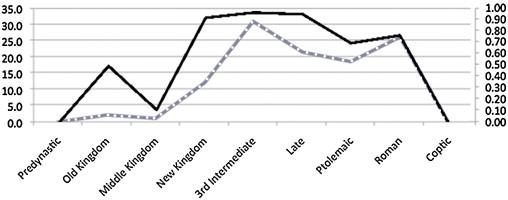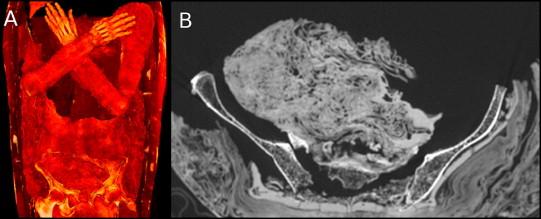A.D. Wade, A.J. Nelson / University of Western Ontario
Source - http://www.sciencedirect.com/science/article/pii/S0018442X12001278
HOMO - Journal of Comparative Human Biology, Volume 64, Issue 1, February 2013, Pages 1–28
Abstract
Descriptions of the preparation of ancient Egyptian mummies that appear in both scientific and popular literature are derived largely from accounts by the Greek historians Herodotus and Diodorus Siculus. Our reliance on these normative descriptions obscures the wide range of techniques practised, and so stifles the study of geographic, chronological, and social variations in the practice. Using published descriptions in the literature for 150 mummies and 3D reconstructions from computed tomography data for 7 mummies, this study compares empirical data with classical descriptions of evisceration, organ treatment, and body cavity treatment. Techniques for accessing the body cavity, removal and treatment of the organs, and treatment of the eviscerated body cavity vary with time period, sex, and status, and are discussed in relation to their treatment in the literature and their radiological appearance. The Herodotean and Diodorean stereotypes, including the restriction of transabdominal evisceration to the elite and cedar oil enema evisceration to commoners, are falsified by the data. The transperineal forms are present only in elites, and chemical evisceration is not apparent at all. Additionally, the dogmatic contention that the heart was universally retained in situ, or replaced if accidentally removed, is also greatly exaggerated.

Fig. 1. Graph showing the count and fractional frequencies of evisceration (grey dotted line, scale left – count; black line, scale right – fraction) by time period. Examples with dates across one or more time period were divided equally between both periods.

Fig. 3. CT scan and reconstructions of RM-2718, showing (A) the left transabdominal evisceration incision viewed from inside the body cavity; (B) the intact heart, possible organ package, and solidified straight level of resin; and (C) damage to the posterior of the mummy (note the straight cuts above, below, and along the midline).

Fig. 4. CT scan and reconstruction of Djedmaatesankh, showing (A) the abdominal packing and the transabdominal incision beneath the incision plate; (B) the possible organ packages throughout the body cavity; and (C) the incision plate, scarab, and pectoral.

Fig. 5. CT scan and reconstruction of Lady Hudson, showing (A) the pelvic packing and damaged thorax (note the coffin boards visible beneath the thoracic cavity); and (B) the linen packing in the pelvis with the small pool of resin on it hinting at a transabdominal evisceration.

Fig. 6. CT scan and reconstructions of Pa-Ib, showing (A) the transabdominal evisceration incision without sutures or incision plate; (B) the linear diaphragm remnants and possible organ packages (#3 and #5); (C) and a cross-sectional view of the solidified straight level of resin with package #5 sticking out.

Fig. 8. CT scan and reconstructions of ROM 910.5.3, showing (A) the large transperineal evisceration orifice; (B) the great vessel remnants in the incised pericardial sac; and (C) a cropped view showing the insect remains (indicated) and the possible pancreas fragment with diaphragm remnants visualised as a dark shadow above it.

Fig. 9. CT scan and reconstruction of the Sulman mummy, showing (A) indications of rewrapping (the dislocations of the forearms and clavicle from their anatomical positions, the loose metacarpal in the outer wrappings, and the 3 curled fingers of the right hand still on the left shoulder despite the extended position of the arms); (B) the remnant bowel loops; and (C) the layer of resin adherent to the pleura.